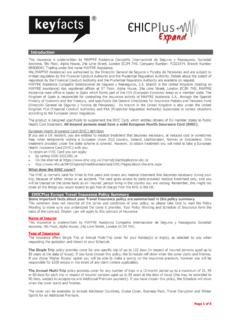Transcription of Social health insurance: Key factors affecting the ...
1 Social health insurance : Key factors affecting the transition towards universal coverage Guy Carrin and Chris James world health organization Geneva Several low- and middle-income countries are interested in extending their existing health insurance for specific groups to eventually cover their entire populations. For those countries interested in such an extension, it is important to understand the factors that affect the transition from incomplete to universal coverage. This paper analyses the experience of eight countries in the implementation of Social health insurance . It highlights the importance of the socioeconomic and political context, particularly in relation to the level of income, structure of the economy, distribution of the population, ability to administer and level of solidarity within the country, but also stresses the important stewardship role government can play in facilitating the transition to universal coverage via Social health insurance .
2 Social health insurance (SHI) is one of the principal methods of health financing. Twenty-seven countries have established the principle of universal coverage via this Several low- and middle-income countries are currently interested in extending their existing health insurance for specific groups to eventually cover their entire populations. For those countries interested in such an extension, it is important to understand the factors that affect the transition from incomplete to universal coverage. Other authors have analysed key questions that need to be considered before a country embarks on the extension or establishment of SHI, along with implementation This paper adds to the literature by analysing the transition to universal coverage via SHI. For analysis of the performance of an SHI scheme during implementation, the reader is referred to Carrin and James (2004); for assessment of the performance of mature SHI schemes in western Europe, see Saltman et al.
3 (forthcoming). 1 Based on Carrin et al. (2004). The authors are with the WHO's Department of health System Financing, Expenditure and Resource Allocation. Comments and suggestions from Jan van Lente, Jean Perrot, William Savedoff and two anonymous referees are gratefully acknowledged. All views expressed in this paper are entirely those of the authors and do not necessarily represent those of the world health organization . 2. See Normand and Weber, 1994, Icon, 1993. International Social Security Association, 2005 International Social Security Review, Vol. 58, 1/2005. Published by Blackwell Publishing Ltd, 9600 Garsington Road, Oxford QX4 2DQ, UK and 350 Main Street, Malden, MA 02148, USA. Social health insurance : Key factors affecting the transition towards universal coverage Social health insurance as an option for reaching universal coverage A question that remains of paramount importance in a majority of the world 's countries is how their health financing systems can provide sufficient financial risk protection to all of the population against the costs of healthcare.
4 The latter objective is tantamount to the aim of universal coverage, which is to secure access to adequate healthcare for all at an affordable price. That is, universal coverage incorporates two different coverage dimensions: healthcare coverage (adequate healthcare) and population coverage (healthcare for all). A crucial concept in health financing policy towards universal coverage is that of society risk pooling, whereby all individuals and households share the financing of total healthcare costs. The larger the degree of risk pooling in a health financing system, the less people will have to bear the financial consequences of their own health risks, and the more they are likely to have access to the care they need. There are essentially two main options for achieving universal coverage. One is a health financing system whereby general tax revenue is the main source of financing health services.
5 These health services are usually provided by a network of public and contracted private providers, often referred to as a national health service. Second, there is SHI, which in principle involves compulsory membership among all of the population. Workers, self-employed, enterprises and government pay contributions into a Social health insurance fund. The base for workers' and enterprises' contributions is usually the worker's salary. The contributions of self-employed persons are either flat-rate or based on estimated income. Government may provide contributions for those who otherwise would not be able to pay, such as unemployed people and low-income informal economy workers. SHI either owns its own provider networks, works with accredited public and private healthcare providers, or uses a combination of both.
6 Within SHI, a number of functions (for example registration, collection of contributions, contracting and reimbursement of providers) may also be executed by parastatal or non- governmental institutions, often referred to as sickness funds. We do see countries, however, which use a mix of the two main options. Thus, there are mixed health financing systems that have some part of the population partially covered via general tax revenue, and clearly specified population groups only covered by health insurance . This insurance can be provided by one or a number of parastatal health insurance schemes that function according to SHI principles. Alternatively, a system of private health insurers may also be in place, but one that is subject to government regulatory powers, especially ensuring a specified benefit package of care.
7 Note finally that within each of the options referred to above, private health insurance can also play a supplementary It typically covers extra healthcare services that are not covered in a basic package of care (of one of the three systems described above), arranges for a reduction in waiting time, or covers some of the cost of patient repayments. Indeed, in reality no health financing system is entirely financed by general taxation, SHI or the mixed health financing system described above. However, these options are useful for describing what is the principal method driving a health financing system towards universal coverage. In this paper we focus on the development of SHI, especially in low- and middle-income countries, given that a choice is made in favour of this particular pathway.
8 It will be supposed that the basic feasibility questions have been answered properly by the country that has made such a choice. This means that the country has analysed carefully the pros and cons of general taxation, SHI and a mix of the two as options for reaching universal coverage. The next section will address important facilitating factors that can speed up this transition period, based on the experience in a selection of countries with developed SHI schemes. 3 See Sekhri and Savedoff (2003). International Social Security Association, 2005 International Social Security Review, Vol. 58, 1/2005. Social health insurance : Key factors affecting the transition towards universal coverage Towards universal coverage via Social health insurance : General factors that affect the speed of transition One can appreciate that achieving universal coverage may not be an easy process.
9 Many countries that currently have a universal coverage system often needed decades to implement it. But if the choice is to take the path of SHI, several factors may be slowing down the process towards universal coverage. These are discussed in the "Facilitating factors " section below. In order to assess past experience on the transition to universal coverage via SHI, we use data about the evolution of the health insurance legislation in eight SHI countries for which sufficient information was readily available. These countries are Austria, Belgium, Costa Rica, Germany, Israel, Japan, Republic of Korea (ROK). and We will pay attention thereby to the variety of organizational forms used during the transition period in those countries. In particular, the role of the voluntary character of sickness funds in the initial phases of SHI implementation will be highlighted.
10 The transition period was defined as the number of years between the first law related to health insurance and the final law voted to implement universal coverage. The numbers of years of transition are 79 (Austria), 118. (Belgium), 20 (Costa Rica), 127 (Germany), 84 (Israel), 36 (Japan), 26 (ROK) and 72 (Luxembourg). Note, though, that Costa Rica's final law introduced the principle of universal coverage via SHI rather than effectively providing universal insurance coverage subsequent to this law. In Japan, the 1958 law on compulsory health insurance was implemented three years later. Further, in Israel, the estimate of 84 years includes 37 years of Social health insurance before Israel as a sovereign State was established. It is not simply the total length of the transition period that is important, however.
















